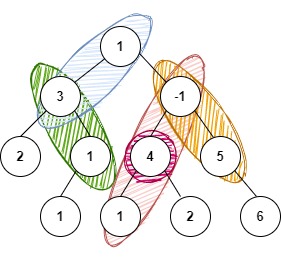K - Sum Path In A Binary Tree
Given a binary tree where each node contains an integer value, and a value 'K', your task is to find all the paths in the binary tree such that the sum of the node values in each path equals 'K'.
Example:
Input:
tree = [1, 2, 3, 4, -1, 5, 6, -1, 7, -1, -1, -1, -1, -1, -1]
K = 4
Output:
[ [1, 3], [3, 1], [-1, 4, 1], [4], [-1, 5] ]
Explanation:

[1, 3], [3, 1], [-1, 4, 1], [4], and [-1, 5] are paths where the sum of values is 4.
Constraints:
1 ≤ T ≤ 501 ≤ N ≤ 10^2-10^9 ≤ K ≤ 10^9-10^7 ≤ DATA ≤ 10^7
Note:
The path can start and end anywhere, but it must move downwards (from parent to child). Implement the function and return paths in order; you don't need to print.

AnswerBot
4mo
Find all paths in a binary tree with nodes summing up to a given value K.
Traverse the binary tree and keep track of the current path and its sum.
At each node, check if the sum equals K and store the p...read more
Help your peers!


Add answer anonymously...
Nagarro Software Developer interview questions & answers
A Software Developer was asked 3mo agoQ. Design and implement a data structure for Least Recently Used (LRU) cache. It sh...read more
A Software Developer was asked 3mo agoQ. Given the root of a binary search tree, and an integer k, return the kth smalles...read more
A Software Developer was asked 5mo agoQ. What is abstraction in Java?
Popular interview questions of Software Developer
A Software Developer was asked 3mo agoQ1. Design and implement a data structure for Least Recently Used (LRU) cache. It sh...read more
A Software Developer was asked 3mo agoQ2. Given the root of a binary search tree, and an integer k, return the kth smalles...read more
A Software Developer was asked 5mo agoQ3. What is abstraction in Java?
Stay ahead in your career. Get AmbitionBox app


Trusted by over 1.5 Crore job seekers to find their right fit company
80 L+
Reviews
10L+
Interviews
4 Cr+
Salaries
1.5 Cr+
Users
Contribute to help millions
AmbitionBox Awards
Get AmbitionBox app













